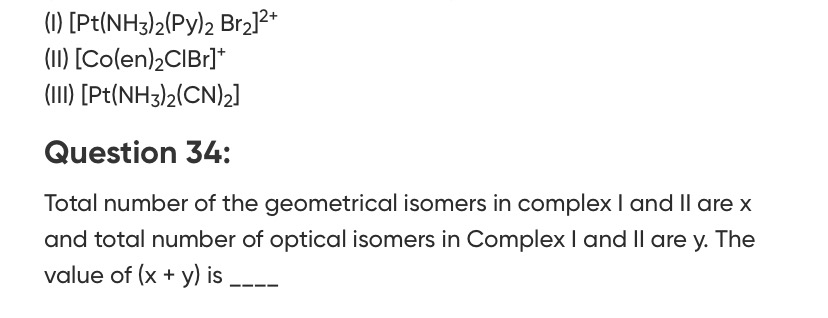Question
Question: Total number of the geometrical isomers in complex I and II are x and total number of optical isomer...
Total number of the geometrical isomers in complex I and II are x and total number of optical isomers in Complex I and II are y. The value of (x + y) is _____

Answer
15
Explanation
Solution
Complex (I) [Pt(NH3)2(Py)2 Br2]2+ is interpreted as an octahedral complex of the type [MA2B2C2]. It has 5 geometrical isomers. The optical isomers are:
- A-A (trans), B-B (cis), C-C (cis): Achiral (0 optical isomers)
- A-A (trans), B-B (trans), C-C (trans): Achiral (0 optical isomers)
- A-A (cis), B-B (cis), C-C (cis): Chiral (2 optical isomers)
- A-A (cis), B-B (cis), C-C (trans): Chiral (2 optical isomers)
- A-A (cis), B-B (trans), C-C (trans): Chiral (2 optical isomers) Total optical isomers for Complex (I) = 0+0+2+2+2=6.
Complex (II) [Co(en)2CIBr]+ is an octahedral complex of the type [M(AA)2BC]. The 'en' ligand is bidentate.
- Geometrical Isomers:
- Cl and Br are trans: 1 isomer (achiral).
- Cl and Br are cis: 1 isomer (chiral). Total geometrical isomers for Complex (II) = 1+1=2.
- Optical Isomers:
- The trans isomer is achiral (0 optical isomers).
- The cis isomer is chiral (2 optical isomers). Total optical isomers for Complex (II) = 0+2=2.
Total number of geometrical isomers (x) = Geometrical isomers of (I) + Geometrical isomers of (II) = 5+2=7. Total number of optical isomers (y) = Optical isomers of (I) + Optical isomers of (II) = 6+2=8.
The value of (x + y) = 7+8=15.
